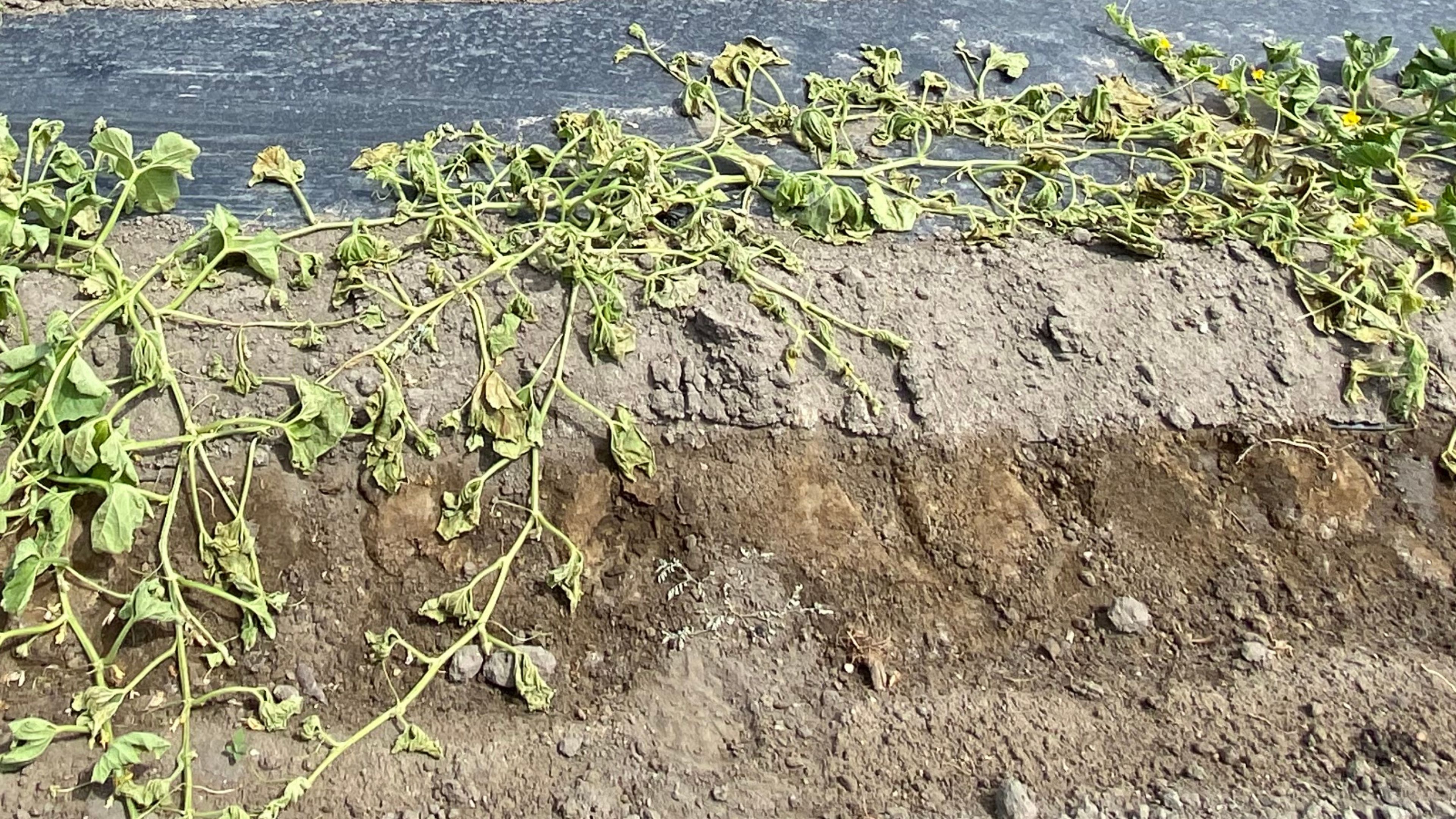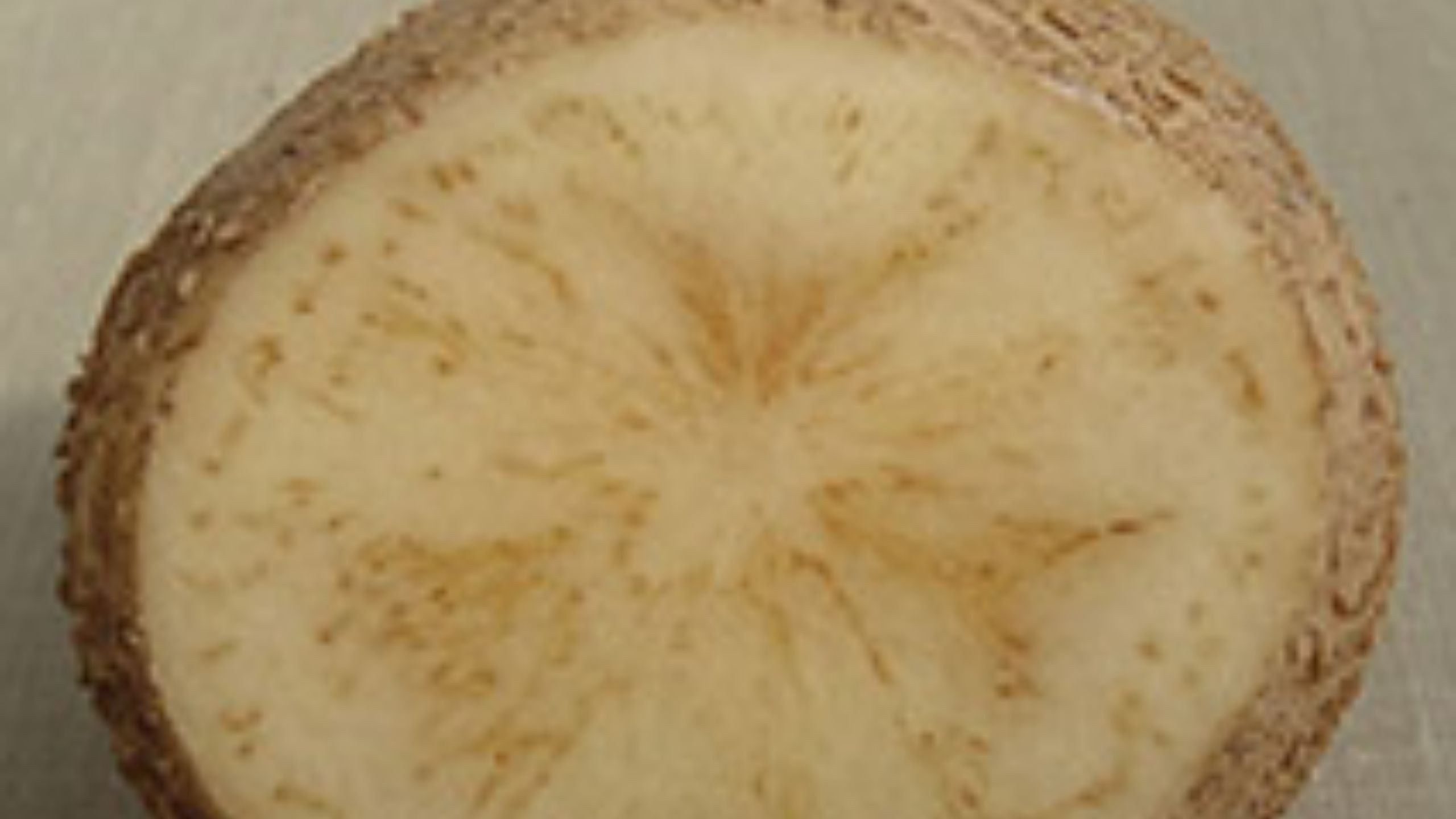Botrytis Neck Rot of Onion
November 2013
Claudia Nischwitz, Extension Plant Pathologist • Christine Dhiman, Research Assistant • Dan Drost, Extension Vegetable
Specialist

Fig. 1. Early symptoms of Botrytis neck rot of storage
onion. Note darker water soaked areas near the neck.

Fig. 2. Advanced infection with Botrytis

Fig. 3. Sporulation (see arrow) of Botrytis sp. on surface
of onion bulb

Fig. 4. Onion bulb with dried cured neck in the field
Quick Facts
- Botrytis neck rot is a post-harvest storage disease
- It is caused by the fungi Botrytis aclada and B. allii
- Infections occur in the field mainly through uncured necks but pathogen remains inactive until weeks later
- Bulbs start rotting 4-8 weeks after they go into storage
- Disease can be minimized by proper drying of bulbs at harvest
Botrytis neck rot is caused by Botrytis acclada and B. allii. The fungi are specific to members in the Alliaceae (onion and garlic) and can be found in all onion producing regions around the world. They occur in the soil and can be seedborne. Botrytis can grow and produce spores on dry onion leaf tissue in the field and spores are blown around by wind and can infect wounded bulbs. However, the single most important point of infections is through soft, green neck tissue of the onion bulb. Botrytis aclada and B. allii become a problem in storage when onions are harvested immature and can result in more than 30% yield loss. The disease can be drastically reduced if onion production guidelines are followed.
Symptoms
Initially, scales become water-soaked in the neck area and then as the fungus grows, the scales turn brown at the neck (Fig. 1). Botrytis continues to move through the bulb to the basal plate (Fig. 2) and the scales turn brown and dry up. Sclerotia can develop on the outside of an infected bulb or between the scales. Frequently, Botrytis will produce spores on the outside of the bulb (Fig. 3) and gray mycelium can sometimes be seen growing between the scales. Infected bulbs may have a sunken appearance due to the dried up tissue and feel spongy in the neck area.
Disease Cycle
Infections occur during the growing season in the field but the visual symptoms are not obvious until the bulbs are in storage. Both species survive in the soil as sclerotia which are hard black balls of fungal tissue or can be seedborne. Sclerotia are viable in the soil for more than two years without a host present. When onions are planted the sclerotia germinate and grow hyphae that infect onion tissue through wounds. If the sclerotia are associated with dead onion tissue they produce spores that can infect living tissue. Infections occur from contaminated seed when the fungus grows from the seed to leaves and colonizes them. In all cases, the onion tissue remains symptomless which is called a latent infection. Infection from spores produced on dead onion tissue (cull onions) occur during moist cool weather when temperatures are between 50-75 F. The spores are spread by wind and if the spores land on bulbs with wounds or bulbs with succulent necks at harvest, they germinate and enter the bulb and moist necks tissues (Lacy and Lorbeer, 2008). After the bulbs are placed in storage, it takes 1-2 months before rot develops under storage conditions. The disease is most severe when there is poor ventilation, high humidity and temperatures above 40F in storage. Botrytis frequently sporulates on the surface of infected bulbs in storage but new infections of healthy bulbs in storage do not occur because the two species cannot enter a healthy bulb (Delahaut and Stevenson, 2004).
Management
There are no resistant cultivars available for Botrytis neck rot. A combination of management tools is necessary
to minimize losses to neck rot. Cull onions (cull piles and volunteer plants) should be buried in onion growing region. Botrytis spores produced on the culls will be blown for miles by the wind. A three to four year crop rotation helps reduce inoculum that is located in the field and allows onion debris in the field to completely decompose (Schwartz, 2011). Growers should follow appropriate onion production guidelines and not apply nitrogen fertilizer after bulb initiation. Harvest only fully mature and well-cured bulbs (Fig. 4). Curing can be accelerated by undercutting onions during dry weather when they are mature. Late applications of fungicides such as
chlorothalonil, Switch 62.5 WG or Pristine can decrease infections especially if it is rainy during harvest (Schwartz, 2011). Artificial drying using forced warm air (93F) may be necessary if wet weather conditions are present during harvest to speed up curing and reducing neck rot incidence (Lacy and Lorbeer, 2008). Store dry onions at 33-40F with 70-75% humidity. Since neck rot can be seedborne, plant only seed free of the pathogen or treat seed with fungicides like Thiram.
References and Further Reading
- Delahaut, K., and Stevenson, W. 2004. Onion disorders: Botrytis leaf blight, leaf fleck, and neck rot. A3803 University of Wisconsin Extension publication.
- Lacy, M.L., and Lorbeer, J.W. 2008. Neck rot. In: Compendium of onion diseases. Second edition. Schwartz, H.F. and Mohan, S.K. (eds.) APS Press, St. Paul, MN.
- Schwartz, H. 2011. Botrytis, Downy Mildew and Purple Blotch of Onion. Fact sheet No. 2.941. Colorado State University Extension.
Related Research




















